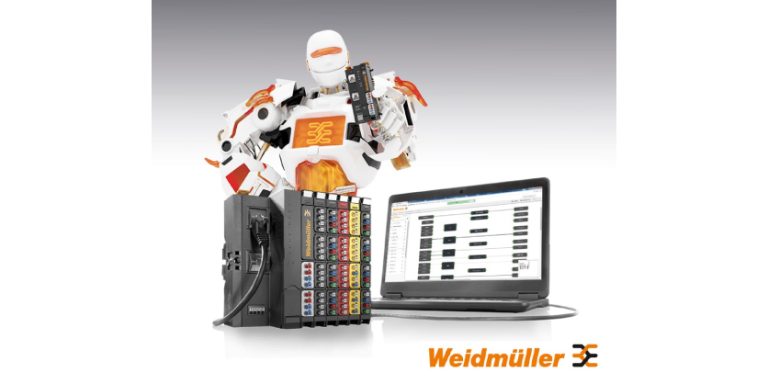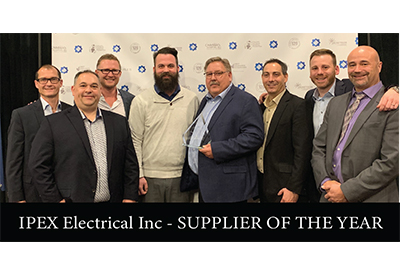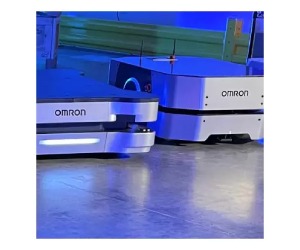How Humber is Putting Canada on the World Stage for Mechatronics and Supporting Workforce Development
July 18, 2025

By Krystie Johnston
Humber Polytechnic is a technical institute located in the Greater Toronto Area of Ontario, and it has a long history of building brilliance and training the workforce of the future. In this article, Neal Mohammed, Director of the Barrett Centre for Innovation Technology shares his insights about Humber’s initiatives in Mechatronics and workforce development.
A leader in training and workforce development
Mohammed, a dynamic and valued member of the Humber Polytechnic community since 1993, Neal brings more than 30 years of combined industry and education experience. He has led roles teaching, coordinating, and directing various education and workforce development programs.
He recalls that he was brought to Humber to spearhead a new initiative: The Canadian Plastics Training Centre (CPTC), It was a training centre funded by the federal and provincial government to service the automotive and advanced manufacturing industry by providing workforce development and training for employees in these industries.
“We were the only institute in Canada [at the time] providing a variety of training solutions for the automotive sector in the plastics technology world,” recalls Mohammed. “The centre was equipped with state-of-that-art equipment from Husky Injection Moulding, Engel, Battenfeld, Brampton Engineering, and PC Hiens to name a few. We had great staff comprised of internal and external professionals who consigned their time to help create and deliver training.”
During his time with the Canadian Plastics Training Centre here at Humber, Neal spent a substantial amount of time visiting industries, conducting needs assessment, and providing custom training and certification solution. He managed many training programs with some top companies including Magna International, General Motors, Toyota, Husky, Collins & Aikman, Stanpac, Denso, and Polytainers, to name a few. He would assess and develop a training plan to upskill the employees in these facilities to increase knowledge and manufacturing efficiency essentially every day of the week, all around the world.

“For my first 15 years [at Humber], I was involved in the industry as a provider of workforce development, upskilling, and reskilling in advanced manufacturing. Automotive was a big part of what I did. I was exposed to many different industries,” says Mohammed. “My teaching career started to kick off because of the work I did creating technical training and delivering it to industry.”
Solving the challenges of various industries was fun for Mohammed. He recalls working on a big project with Sony Music. They approached him and the CPTC to provide training for employees as they were transitioning their production facility from vinyl to CDs. He had the opportunity to collaborate with the plastics supplier Bayers to create and deliver custom training to SONY.
The era of the CPTC exposed him to industries ranging from packaging, pharmaceutical, and automotive. “Plastic bags that you see in the grocery store came from a blown film machine. Your detergents bottles at home come from blow molding machines. And the plastics components used on the interior and exterior of vehicles come from a process called injection molding. We had all those capabilities at Humber. We were well-equipped.”
A new era begins: Mechatronics emerges
In 2008, the recession caused the CPTC to be repurposed. Companies were outsourcing business to other countries, and they were not investing in training locally. A smaller facility ran for a few years, but was eventually closed, and Mohammed transitioned to the Faculty of Applied Science and Technology Department. “My skills working in automotive and advanced manufacturing were transferrable,” Mohammed says. “Luckily, an opportunity came up and I took it. I became the program coordinator to look after the electromechanical engineering program. I would say a new chapter began.”
Mohammed transitioned easily into a teaching role. He had many resources available to work with from his time with the CPTC: real-world examples, hands-on experience, industry knowledge, videos and photographs to share. Mohammed says, “I would build my Presentation using examples for my experience and show the students and say, ‘This is real. This is what you need to know and prepare for your career in the industry. These are the challenges you will face and need to overcome.’ And I think that bringing that real world experience into the classroom captured the student’s interest. And I enjoyed every moment of it.”
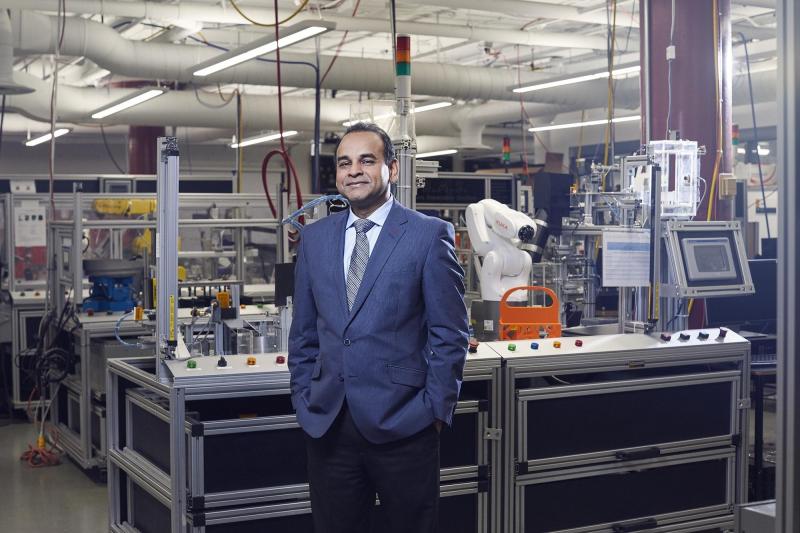
Teaching became a motivation for Mohammed. And he began to pursue training in mechatronics competitions in the early 2000s, something he is actively involved in today.
When Mohammed took on this challenge, he did not know what was needed to compete at the Skills Ontario provincial level. But he figured it out. It was the same story for the national level. Having trained students to compete in mechatronics at the provincial and national levels – and win – he set his sights on winning at the international level.
“Finally, my first opportunity came up. I went to a world competition in London, England. It was exploratory learning, and leant what it was all about, and I brought that back. And the next year, we won gold and the Provincial and Nationals skills competition. That year, we qualified for Leipzig, Germany.”
This was the first time Humber students competed on the world stage in mechatronics. Mohammed admits that they did not win that year, but this did not deter him from trying again. “We were still learning,” he says. “It took a good eight years to figure out how to prepare students to compete at international level, what equipment and tools were required, selecting the right students, the number of training hours required to properly prepare students, and all the things a trainer needs to do. I got hooked on it.”
Putting Canada on the world stage
For Mohammed, putting Canada on the world stage for mechatronics became a challenge that he worked to succeed at. He recalls that while he was at the international competition in Germany, he realized that there was not a lot of respect for Canada from the world in mechatronics. When he began competing at the international level for mechatronics, Canada was at the bottom. “China is now the number one contender, because they are resourced and trained seven days per week. They have progressed into a powerhouse. China, South Korea, Japan and Brazil – they were the top four contenders in the world. And I wanted to be with them.”

It took many years for Mohammed to get his students to the top. First, he had to get his students to be the best in Canada. Then they would be ready to beat the best in the world. “In 2017, we represented Team Canada in Abu Dhabi. We won third place, and today, it is the only medal still standing in all North America,” he says. “Canada was on the map: it was won by Humber Polytechnic.”

Mohammed not only trains the students who compete in mechatronics, he also attends every competition. And there have been a lot of competitions.
His students have competed at the Americas in Brazil winning gold, at the Euros, Kazan Russia, France and have placed quite high at all competition. But the big prize is winning at the internationals, where students compete against the best of the best in the world.
“When we won that medal, that third place – even if it was third place – it was such an accomplishment, because Canada was at the bottom of the list. And I took that, over ten years, and I brought us up to the top three.”
“Today, Canada is well respected by the world. When we go onto the international stage, they have a lot of respect for the Canadian competitors because they are well trained and prepared.” In fact, in June of this year, Humber students won gold at the Skills Canada competition in mechatronics, and will be going to Shanghai, China, in 2026 to represent Team Canada. In Canada, Humber Polytechnic is ranked number one in mechatronics competitions, and they have won 50 medals to date.
Micro-credentials and workforce development
As industries evolve and their requirements do too, innovative approaches to training and workforce development must follow suit. Humber is keeping pace with the times by offering innovative training that is fast, targeted, and flexible. Humber is known for working with local industries to develop the talent and skills to support these communities. Mohammed says that industries are interested in flexible solutions to upskill and reskill their employees faster, with more focus.
“Micro-credentials, when they started to evolve, were exactly for that purpose,” Mohammed says. “They are short, focused educational program designed to teach specific skills or knowledge related to a particular field or job. Unlike traditional diploma or degrees, which often take years to complete, micro credentials are typically shorter (ranging from a few hours to a few months), more flexible, and aimed at rapidly upskilling learners.” He adds that micro-credential delivery can be customized and flexible (hybrid, for example) to address different learners. He adds training is evaluated through practical, skill-based assessments that aim to reflect real workplace tasks. This ensures learners don’t just know information—they can use it effectively, making these credentials highly relevant to employers.

Humber’s Continuous Professional Learning (CPL) offers a variety of micro-credentials training that industry can take advantage to upskill or reskill their employees. Humber has the capacity to create any micro-credential that meets industry needs, if there are enough employees to justify it.
The Barrett Centre for Technology Innovation within Humber has several industry partners that they work with to develop their programs. Festo, SICK Sensors, Kuka Robotics, Shunk, DMG MORI and Magna International – just to name a few – that collaborate with Humber to create training focused on upskilling and reskilling. One example is ‘Exploring Mechatronics.’ “It is all in person, hands-on training focused on upskilling plant operators at the Barrett Centre, in partnership with Festo. It is a branded micro-credential, with Festo and Humber. That is the uniqueness. Students will get a branded micro-badge from an industry and institution. That is the benefit of partnership.”
The STEAM Academy to inspire youth with experiential learning
Mohammed says The Barrett Centre for Technology Innovation is renowned for its commitment to advancing technological solutions and fostering innovation. Through its state-of-the-art facilities, expert faculty, and industry partnerships, the Centre serves as a hub for applied research, project development, and collaboration across various disciplines and industries.
He adds Humber Polytechnic is launching an all-new STEAM (Science, Technology, Engineering, Art, and Math) ACADEMY in the fall of 2025 that will provide an innovative and rigorous educational environment for students in grades 6-12. Through the integration of hands-on learning, collaboration with local industries, and a strong emphasis on real-world application, the academy will prepare students for success in an increasingly technology-driven world. Students will receive 12 weeks of training at a cost of only $100. Upon completion, students will receive a certificate of completion, micro badge.
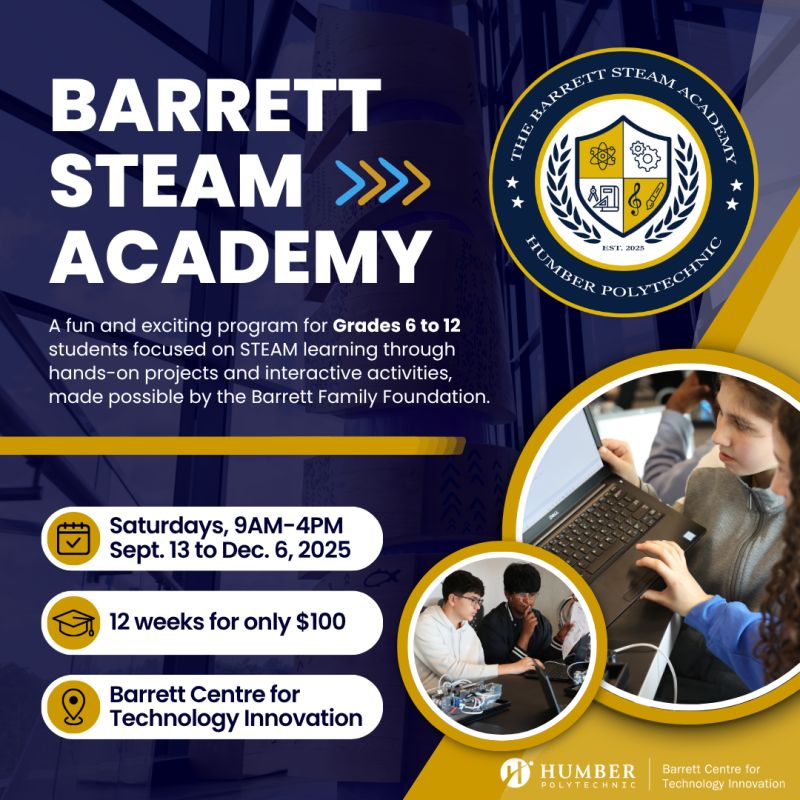
The creation of a STEAM Academy for middle and high school students at the Barrett Centre for Technology Innovation is essential to provide early exposure to STEAM education, close the skills gap, foster innovation and creativity, and engage with the local community. By leveraging its expertise, resources, and partnerships, the Barrett Centre can establish a transformative STEAM Academy that empowers students to excel in the rapidly evolving technology landscape says Mohammed.
Mohammed adds that the Barrett Foundation is strong advocate for inspiring and supporting young people to enter the skilled trades and Engineering field. Not only did they provide one of the largest donations in Humber’s history to establish and maintain the Barrett CTI, but they also recently provided a grant to open the STEAM Academy that will launch this fall.
Conclusion
Humber continues to be a builder of brilliance. Dedicated professionals like Neal Mohammed and industry leaders are working together to support the community and to train the future of the workforce.
Are you interested in learning more? Visit Humber, check out the Barrett STEAM Academy, or reach out to them today!
Related Story
Another Year, Another Gold Medal at Skills Canada for Humber Polytechnic Students
It’s back-to-back gold medal wins at the Skills Canada National Competition for Humber Polytechnic students Grant Maddock and Cole Hunter. The Electromechanical Engineering Technology students earned a gold medal in the Mechatronics Team of Two division last year and followed that up with another first-place finish at this year’s competition.

